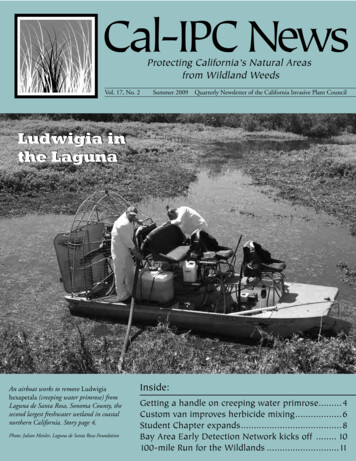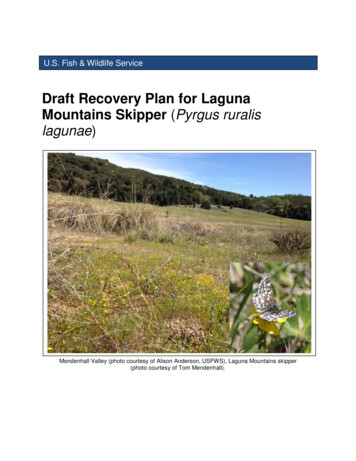
Transcription
Cal-IPC NewsProtecting California’s Natural Areasfrom Wildland WeedsVol. 17, No. 2Summer 2009Quarterly Newsletter of the California Invasive Plant CouncilLudwigia inthe LagunaAn airboat works to remove Ludwigiahexapetala (creeping water primrose) fromLaguna de Santa Rosa, Sonoma County, thesecond largest freshwater wetland in coastalnorthern California. Story page 4.Photo: Julian Meisler, Laguna de Santa Rosa FoundationInside:Getting a handle on creeping water primrose.4Custom van improves herbicide mixing.6Student Chapter expands.8Bay Area Early Detection Network kicks off . 10100-mile Run for the Wildlands.11
From the Director’s DeskThe evolving toolboxCal-IPC1442-A Walnut Street, #462Berkeley, CA 94709(510) 843-3902fax (510) 217-3500www.cal-ipc.orginfo@cal-ipc.orgThe California Invasive Plant Council isa 501(c)3 nonprofit organizationprotecting California’s lands and watersfrom the ecological impacts of invasive plants bypromoting science-based restoration,research, education and policy.STAFFDoug Johnson, Executive Directordwjohnson@cal-ipc.orgElizabeth Brusati, Program Manageredbrusati@cal-ipc.orgHeather Brady, Project Coordinatorhjbrady@cal-ipc.orgBertha McKinley, Program Assistantbmckinley@cal-ipc.orgBOARD OF DIRECTORSJason Giessow, President (2009)Santa Margarita/San Luis Rey Weed Management AreaWendy West, Vice President (2009)U.C. Cooperative ExtensionDoug Gibson, Treasurer (2010)San Elijo Lagoon ConservancyJohn Knapp, Secretary (2009)Native Range, Inc.Dan Gluesenkamp, Past President (2009)Audubon Canyon RanchOne of the primary reasons Cal-IPC formed back in 1992 was to make sure there was away for weed workers to share information on tools and techniques they developed fortreating particular invasive plant situations. Even though we now have loads of informationavailable through our website, there is still a lot of utility in directly sharing how we work onweeds. This issue of Cal-IPC News, as well as the Symposium and upcoming field courses,continue that core tradition.From the “cookie cutter” and “skeleton basket” described in this issue by Julian Meisler, tothe van customized by Shelterbest Builders, a Bay Area contractor, to make herbicide mixingmore efficient, innovative tool development is alive and well. Mark Heath of Shelterbelt willbe sharing info on the van and other innovative tools and techniques at our Symposium inOctober.For the last 17 years, the Symposium has been the best venue for adding to your personaltoolbox by getting information directly from other weed workers statewide. This year inVisalia we’ll hear about the efficacy of particular techniques on particular weeds, as well asthe effectiveness of different programs and the lessons learned. The Symposium will bringupdated research findings that feed directly into applied management techniques, such aswhich native strains are most competitive for revegetation.And Cal-IPC’s field course program, dedicated to growing the individual and collectivetoolboxes of the state’s weed workers, has expanded its field course offerings this year bypresenting full-day courses on Mechanical Control Methods (July 21 in Santa Cruz) andChemical Control Methods (October 7 in Visalia, the day before the Symposium). Thesecourses allow attendees to learn from two experienced leaders in the field—Ken Moore formechanical techniques and Joe DiTomaso for chemical techniques—with more time fordetailed demonstration than in our combined control courses.We have come a long way in developing new tools for wildland weed management, butthere’s plenty more room for improvement for accomplishing long-term restoration success.Let us know what you are doing and share it with your fellow Cal-IPC members!Edith Allen (2010)University of California-RiversideJason Casanova (2010)Los Angeles/San Gabriel Rivers Watershed CouncilHenry Gonzales (2010)Ventura County Department of AgricultureJulie Horenstein (2010)California Department of Fish & GameMarc Lea (2010)San Luis Obispo County Department of AgricultureCheryl McCormick (2010)Carmel, CATanya Meyer (2009)Yolo County Resource Conservation DistrictMark Newhouser (2009)Sonoma Ecology CenterPeter Schuyler (2009)Santa Barbara, CAAffiliations for identification purposes only.Last year of term noted.Cal-IPC NewsSummer 2009 - Volume 17, Number 2Editors: Doug Johnson, Elizabeth BrusatiCal-IPC News is published quarterly by the California InvasivePlant Council. Articles may be reprinted with permission.Submissions are welcome. We reserve the right to edit all work.Mention of commercial products does not imply endoresementby Cal-IPC. Motorized wheelbarrow that Shelterbelt uses to get tools and supplies to remote work sites.Cal-IPC News Summer 2009
Wildland Weed NewsNewsNewsNewsNewsCal-IPC UpdatesUpcoming field coursesThe remaining 2009 classes arescheduled for Visalia (Chemical ControlMethods, Oct. 7) and Pasadena (ControlMethods, Nov. 4, and Mapping, Nov. 5).Restoration volunteers pay just 45 for afull day course! See page 7 and www.calipc.org for more information.2009 SymposiumRegistration is open for our 18th annualSymposium, being held this year in Visaliaon October 8-10. See page 9 and www.cal-ipc.org for more information.On Earth Day, Gov. Schwarzenegger announced that funding for projects supported by California bond measures, includingseveral thousand natural resource projects,could begin moving again. While paymentsfor 2008 invoices are finally being processedin most cases, it is unclear what guaranteesare in place for future payments on restartedprojects. stopworkimpact.ning.comNew grantsCal-IPC has received several new grantsto support our programs. Thank you to:the Resources Legacy Fund for fundingrisk mapping in the Sierra Nevada; theJiJi Foundation for supporting our fieldcourses; the US Forest Service State &Private Forestry program for funding riskmapping in the Sierra; and the San DiegoAssociation of Governments for fundingregional invasive plant assessments andstrategic management planning in SanDiego County. Look for updates on theseprojects in future issues.A recent court decision has thrown intoquestion the rules that govern applicationof pesticides in, over, or near bodies of water. Since 2007, EPA has asserted that pesticides applied in accordance with their legallabels are exempt from additional permitting requirements through the Clean WaterAct. In January the Sixth Circuit Courtof Appeals overruled EPA’s interpretation,meaning natural resource managers mayneed to obtain National Pollutant DischargeElimination System (NPDES) permits toapply pesticides in, over, or near water inthe future. The EPA has filed a motion todelay implementation of this ruling to allowtime to develop and issue appropriate CleanWater Act permits. cfpub.epa.gov/pesticides/news.cfmAccording to a study in the journal Science,monitoring of wildlife imports into theUnited States is fragmented and insufficiently coordinated, increasing the riskof endangered or invasive species beingtransported. More than 86% of shipmentscontained animals that were not identifiedto the species level, making it impossible toassess the full diversity of animals importedor calculate the risk of non-native speciesintroductions and potential for diseasetransmission. The U.S. imported more than1.5 billion live animals between 2000 and2006 . (Science, May 1, 2009)Citizens in Encinitas (San Diego Co.) havestarted a campaign against pampas grass,distributing educational brochures andholding events to teach homeowners howto remove the plant. (San Diego Union-Tribune, May 3)Invasive quagga mussels could cause annuallosses of 22 million to the Lake Tahoeregion if they become established there,according to an estimate by the Army Corpsof Engineers. The report details potentialdamage to tourism, reduced property values,and increased maintenance costs. Boatsentering Lake Tahoe are subject to inspection for mussels, invasive weeds, and otheraquatic invasive species. (Reno Gazette-Journal, June 24, 2009)Join our Facebook groupFind us under “CaliforniaInvasive Plant Council”Hypericum canariense (Canary Island St. Johnswort, at left) is an invasive shrub spreadingalong the San Mateo County coast, and in a few spots in San Diego County. San MateoCounty is petitioning for a formal pest rating from the state. Photo by John Dittes , fromCalphotosCal-IPC News Summer 2009
FeatureLessons from Ludwigia control in Sonoma CountyJulian Meisler, Restoration Program Director, Laguna de Santa Rosa Foundation, Santa Rosa, CASonoma County is home to the secondlargest freshwater wetland in coastalNorthern California, the Laguna deSanta Rosa. Often described as a 14-milewaterway, it is the largest tributary to theRussian River. But unlike a river, the Lagunaoperates more like a bathtub. Duringsummer the surface water level is low andmany of the wetland areas along the 14-milepath become disconnected. But with thearrival of heavy winter rains, a massive,connected, low velocity channel arises andspills variably into its broad floodplain totransform grazing lands, agricultural fields,vineyards, and riparian forests into lakesand swamps. While the ecological servicesit renders are numerous, the Laguna’s lessimpressive distinction is being one of themost impaired water bodies on the NorthCoast. Many factors have contributed toits current condition and the symptomsare manifold. Perhaps the most obvious isthe dramatic growth of the aquatic weedLudwigia hexapetala.A growing problemHailing from South America, L.hexapetala is increasingly problematic inCalifornia and elsewhere on the West Coast.In keeping with its common name, creepingwater primrose, this plant roots at themargins of ponds, lakes, rivers, ditches andother wetland types and slowly creeps acrossthe water surface to form dense mats thatexclude other species, reduce flood capacity,and likely alter food webs. Emergentstems can grow to more than four feetand produce brilliant yellow flowers thatpeak sometime in early July. Reproductionis both sexual and vegetative. Becauseeach node can produce new roots, smallfragments created during removal effortspose a serious risk of spread.L. hexapetala competes well with mostnative marsh vegetation. While open sunnyareas are perhaps ideal, it can grow wellunder riparian canopy. Nutrient-rich watersencourage its growth and yet the relativelyclean waters of the Russian River alsosupport robust populations. In the Lagunaitself, the only observed limitations togrowth are deep water ( 5 ft), especially incombination with large surface area of openwater, and extended periods of desiccation.However, even seemingly dry soils in thefloodplain can support the plant, though itsgrowth is limited.While it is possible that L. hexapetalahas been in the Laguna for decades, it seemsthat a tipping point was reached in theearly part of this decade that enabled theplant to dominate many areas of shallow,stagnant water ranging from small pondsto freshwater marshes exceeding 200 acresin size. Despite concerns raised by localbiologists and others, it was not until thelocal Mosquito District became alarmedthat concern turned to action.A planned responseIn 2004, the District captured recordnumbers of adult mosquitoes in trapsadjacent to the densest L. hexapetalainfestations. This coincided with the arrivalof West Nile Virus and suddenly the L.hexapetala invasion was no longer just anecological threat, it was a perceived threatto public health. The local press picked upthe story and it became clear that if leftunattended, this weed was a liability thatcould open up lawsuits if no action wastaken.A Task Force was soon formed, led bythe Laguna de Santa Rosa Foundation,a local non-profit organization focusedon the Laguna. Its members includedscientists, policy makers, local, state andfederal resource and regulatory agencies,and elected officials. Within a year a planwas developed and money was raised forthe Laguna Foundation to lead a three-yearcontrol effort in two of the most denselyinfested areas. The plan called for summerherbicide treatment followed by mechanicalAmber Manfree wades through water up to 4-feet deep to establish a transect for monitoring Ludwigia control activities.Inset: Ludwigia flowers are bright yellow. Cal-IPC News Summer 2009
A crane lowers the Cookie Cutter into a sea of Ludwigia hexapetala.removal of the dead and dying biomass.The two control sites included nearly threemiles of channels of variable width anddepth. Common to both were a historyof past disturbance (dredging, widening,outright creation), stagnant summer water,and absence of mature riparian canopy.Also included were nearly 100 acres ofshallow marsh also with a long history ofdisturbance and manipulation. In a typicalyear the marsh’s summertime depth rangedfrom inches to several feet. In winter, thedepth of both the channel and marsh canincrease to more than twenty feet. Thecontrol areas are owned by the SonomaCounty Water Agency and the CaliforniaDepartment of Fish and Game.In a county where the use of herbicide isanathema to many, strong public relationsefforts were paramount and the LagunaFoundation approached it in a variety ofways. Presentations were made to all of thelocal city councils, the Sonoma CountyBoard of Supervisors, Rotary Clubs,environmental organizations, and more.Each year progress updates were providedto each of these entities through reports andpresentations.Prior to herbicide application each year,the Laguna Foundation mailed letters tothe 55 households surrounding the projectarea and submitted press releases to threelocal newspapers. Interviews were given topublic and commercial radio stations andnewspapers. Weekly progress updates wereemailed to over 100 individuals during theactive season each year summarizing whathad occurred in the previous week and whatwas planned for the coming week. Theseupdates were compiled and made availableon the Laguna Foundation website.Large equipment for a large jobWhile the most efficient way to applyherbicide would have been via helicopter,there was considerable opposition to thismethod. In its place were ditch bank rigsThis skeleton basket strains the vegetationbefore loading it onto a truck for removal.(truck with mounted tank and hand-heldhoses) along narrow and accessible channels,an airboat for wider and less accessiblechannels, and a MarshMog in the marsh. AMarshMog is similar to a Sno-Cat used inski areas but equipped to operate in severalfeet of water.Because the airboat could not travelthrough the L. hexapetala mats at the slowand steady speed required for application, anopen water path had to be cleared throughthe channels. This was accomplished with aCookie Cutter, a brutish machine similar inappearance to a small tugboat but equippedwith a large fan blade in the front to chopthrough vegetation. Though quite effective,the machine caused significant spikes inturbidity and produced thousands of plantfragments. For a plant that easily reproducesfrom fragments, this was problematic and afloating boom with a hanging silt screen waserected downstream to capture fragmentsand contain turbidity.Over the three-year project period twoherbicides were tried, glyphosate (productname Glypro ) and triclopyr (productname Renovate 3 ), combined withthe non-ionic surfactant Cygnet Plus .Applications typically began in late June inadherence with NOAA Fisheries regulationsfor salmonid streams.Mechanical removal was accomplishedusing a long-reach backhoe in narrow,accessible channels and aquatic harvestersin access limited channels. Where harvesterswere used, they had to be preceded bythe Cookie Cutter, which chopped thedead biomass. In the marsh area it becameclear that removal would be prohibitivelyexpensive and sprayed vegetation had to beleft in place.To reduce turbidity, removal wasconducted from upstream to downstream sothe dense mats would filter muddy plumescoming downstream. To reduce the volumeof sediment dredged with each scoop ofthe backhoe, the contractor constructed a“skeleton” bucket that strained each scoop ofvegetation before it was loaded for hauling.This greatly reduced the risk of leaking haultrucks on public roads, or worse, burstinga tailgate and dropping several tons of L.hexapetala, mud and water on the road. (Ithas happened!)The vegetation and accompanying muckwere hauled to nearby farm fields and discedinto the soil.Mixed resultsThe results were highly variable andinfluenced by a variety of factors. Whiledeeper channels retained the effects ofspraying and removal for two years,moderate regrowth began after three yearsand several sites returned to near completecoverage after four years.Shallow channels could not be effectivelycontrolled with the methods used.Continued page 12.Cal-IPC News Summer 2009
Tools and TechniquesCustom work van makes herbicide mixingmore efficientMark Heath, Shelterbelt Builders, Inc. (interviewd by Doug Johnson)Shelterbelt Builders, Inc., is a Berkeley-basedcompany specializing in project design andimplementation for restoration and wildlandweed control (www.shelterbeltbuilders.com).President Mark Heath recently gave us a tourof the innovative van they customized forprojects involving herbicide application.“The beauty of the van is that herbicide can be mixed quickly by asingle person without handling or even seeing any concentrate—a true closed mixingsystem for small-scale jobs. This reduces thepotential for contact or spills. Also, you canmake just the amount you need, so it cutsway down on leftover mix.“Our simplified version of direct injection works just like the more common andsophisticated computer controlled versionused by large production nurseries andrights-of-way managers. A local spray partssupplier, American Cleanway in San Leandro, installed this for us for around 4,000.“We have a 30-gallon clean water tank,enough for four backpack sprayers for aday. The herbicide concentrate is lockedin its own compartment and only mixeswith water just before being dispensed intoa backpack sprayer. We have Aquamaster,Habitat, and Garlon 4 connected up, aswell as R11 and Competitor surfactants andsome dye.”“The valves are calibrated to dispenseeach herbicide at a given rate. The userfigures out how much mix they want, froma half gallon up to a full backpack-full.Then depending on what concentrationyou need, the chart tells you how long to fillBackpack sprayers are filled at the rearbumper. The system takes about a minute tofill a backpack sprayer, with no handling ofherbicide containers.with herbicide from the valve at the bumper.After putting in the herbicide, you fill up tofinal volume with plain water. It takes abouta minute to fill a backpack.”“In terms of backpack sprayers, we’vemade our own. We get our backpack framesfrom Mystery Ranch, and add the tanks andsprayers. The final cost is around 500 each.They’re a big improvement when you’rewearing them long hours in a wildland situation.”Mark at the manifold where valves are calibrated for each herbicide. The water reservoir ismounted at right, behind backpack sprayer. Cal-IPC News Summer 2009Mark Heath will be one of the instructors atthe October field course on Chemical ControlTechniques and a speaker at the Symposiumin Visalia. Contact him at mark@shelterbeltbuilders.com or (510) 841-0911.
Above: Tables provide details on amount of each herbicide to load givenan application rate and volume of herbicide needed. Right: Adjuvantssuch as dies and surfactants are stored in the van.Chemical Control Methods Field CourseOctober 7, 2009Kaweah Oaks Preserve & Exeter Woman’s ClubThis year’s pre-Symposium field course near Visalia is a bookend to our Mechanical Control Wildland Weed Field Course (taking place July 21 in the Santa CruzMountains). These full-day courses provide an opportunity to go into more detailthan in our single-day overview course covering all control methods.Join Cal-IPC and expert instructors to learn the most essential chemical controltechniques, giving you the tools to take your weed management program to thenext level. In-depth instruction, practical demonstrations, and hands-on activities,including: Principles of chemical control Specific herbicides and target species Calibration of equipment Applications methods, large- and small-scale Treatment of grasses, forbs and woody plants Safety precautions, including transportation of herbicidesDPR continuing education units will be available.Register online at www.cal-ipc.org/fieldcourses. You may register for this courseeven if you are not attending the Symposium.Scott Oneto demonstrates spray techniques at aWildland Weed Field Course in South Lake Tahoe.Cal-IPC News Summer 2009
Cal-IPC Student Chapter continues to growHeather Schneider, Cal-IPC Student Chapter Co-chair, Riverside Branch, University of California, Riverside, calipcsc@gmail.comThe Cal-IPC Student Chapter hascontinued to be busy and productivethis year, participating in events at both thestate and local level. One of our biggest andmost exciting achievements is the establishment of a second Cal-IPC SC branch atUC Davis! The branch is brand new andyou’ll be hearing more from them in thenear future. We are currently contactingschools throughout the state to continue theexpansion of Cal-IPC SC. Please see belowfor a more comprehensive list of our latestactivities. We’re also proud to introducetwo more of our board members!Lynn SweetCal-IPC SC Secretary, Riverside BranchLynn grew up in Maine and attendedDickinson College, where she earned a B.S.in Biology in 2001. She first took on theissue of invasive plants working at the BLMCody Field Office in Wyoming as a StudentConservation Association intern. She iscompleting her 3rd year of a Ph.D. programunder Dr. Jodie Holt at UC Riverside.Lynn’s dissertation focuses on the factorsinfluencing the distribution of Pennisetumsetaceum, purple fountain grass, in southernCalifornia. This year, she will begin fieldwork in central Riverside County looking atpotential distribution, associated vegetation,and competitive balance of plants in a desertecosystem.Mike BellCal-IPC SC Webmaster, Riverside BranchMike grew up on the Santa Rosa Plateauin Murrieta, CA, where he started fightingweeds at an early age alongside his mom,reserve manager Carole Bell. Mike receivedhis B.S. from UC Santa Barbara and thenworked for the National Park Service. Heis a 2nd year PhD student at UC Riverside,where he works with Dr. Edith Allen measuring the effects of anthropogenic (humancaused) nitrogen deposition on the spreadof invasive species in the desert. His projectwill use stable isotopes to track depositionacross Joshua Tree National Park and measure the effects of deposition on nitrogencycling within the soil. Cal-IPC Student Chapter members celebrate their hard work removing Himalayanblackberry at the Santa Rosa Plateau Ecological Reserve.Our recent activities: Statewide WMA meeting Invasive Weeds Awareness Day at theCapitol Local WMA meetings Created a Cal-IPC SC website Santa Rosa Plateau Plant Sale Rancho Santa Ana Botanic Garden PlantSale UCR Botanic Garden Plant Sale Presented grad student research at a Riverside/San Bernardino CNPS Meeting Riverside Citizens Science Week Santa Rosa Plateau Himalayan blackberryremoval work day Western Municipal Water District Earth Night Long Beach Earth Day Santa Rosa Plateau research/weed management consultation Plant survey for Camp Yolijwain Yucaipa Assisting with the upcomingCal-IPC Symposiumyour area, or just participate in events, let usknow! If you’re a researcher, land manager,or other professional and you have an ideafor how the student chapter can work withyou or your organization, please contact us!Our goal is collaboration and communication between students, professionals, andthe community at large and we need yourhelp. See you in Visalia!To contact us:Email:riverside@calipcsc.orgWebsite: http://calipcsc.orgFacebook: www.facebook.com(search “Cal-IPC Student Chapter”)We’re proud of what we’ve accomplished so far, and we’realways looking for new membersand new opportunities. If you’re astudent and you’d like to join Cal- Student Chapter members Mike Bell and Lynn SweetIPC SC, start a new branch inat Long Beach Earth Day.Cal-IPC News Summer 2009
2009 Cal-IPC Symposium"Wildland Weed Management on the Leading Edge" Visalia Convention Center, Visalia, CAOctober 8-10, 2009 - field course October 7Featured SpeakersKeynote address: California’s fading wildflowers: Lost legacy andbiological invasion, Richard Minnich, UC RiversideManaging the leading edge: Landscape-level control of invasiveplant spread in the Sierra and beyond, Wendy West, UC CooperativeExtensionFrom foothills grasslands to alpine peaks:Managing weeds at the leading edge inSequoia and Kings Canyon NationalParks, Athena Demetry, Sequoia-KingsCanyon National ParksThe roles of animals and disturbance inplant invasion: Lessons from the CarrizoPlain, Paula Schiffman, CSU NorthridgeWhat would Aldo think? A look atherbicide ecotoxicology, Joel Trumbo,California Department of Fish & GameAdaptive value of remnant native plants in invaded communities:Examples from the Great Basin, Elizabeth Leger, University ofNevada, RenoFrom backpacks to jetpacks, handpicks to skid steers: Leveragingold tools and new techniques for longterm restoration success, Mark Heath,Shelterbelt BuildersClimate change: Strategies to managebiodiversity through acquisition andrestoration, Rick Rayburn, CaliforniaState ParksUpdates on CDFA’s Noxious Weedrating system, Katie Filippini, CaliforniaDepartment of Food & AgricultureThe importance of vouchering for plantidentifications, Fred Hrusa, CaliforniaDepartment of Food & AgricultureInteractions between fire and plantinvasions under a warming climate in theSierra Nevada Bioregion, Matt Brooks, US Geological SurveyNew tools and techniques: A survey fromaround California, Joseph DiTomaso, UC DavisPromise and pitfalls of species distribution modeling to predictfuture invasions, Nicole Heller, Climate CentralFull program online. Dept. of Pesticide Regulation CE credits,including 2 hrs. Laws & Regs, available for licensed applicators.Photo ContestRaffle and AuctionSubmit entries by September 1! Photos will be displayed at theSymposium and attendees will vote on their favorites. Not just afun competition, the photo contest is valuable source of imagesfor our educational materials. See the Symposium website forinstructions for submitting entries.The annual raffle and auction is a fun event for Symposiumattendees and a fundraiser for Cal-IPC. Books, wine, tools, art,and some fabulous trips will all be up for grabs. Do you havesomething to donate? Contact Tanya Meyer, meyer@yolorcd.org,or call the Cal-IPC office.And More.To Register.Discussion groups § Student Paper & PosterContest § Saturday field trips § Sponsorexhibits § Job board § More papers & postersplus the Chemical Control Methods FieldCourse (see p. 7)Online form at www.cal-ipc.org supports payment options including sending a check.Register and reserve lodging by September 14for early bird discounts. Additional discounts forstudents and Symposium volunteers.full details at www.cal-ipc.orgCal-IPC News Summer 2009
Bay Area Early Detection Network gets rollingDaniel Gluesenkamp, Audubon Canyon RanchWhether we are protecting humans fromswine flu or protecting rivers from Arundodonax, early detection and rapid response(EDRR) is the most cost-effective approach for coping with biological invasions.Indeed, the official California InvasiveWeed Action Plan identifies EDRR as “thesingle most important element” for copingwith invasions. EDRR is a “stitch-in-time”approach which proactively deals withinfestations before they can grow into largeand costly environmental threats. By actingearly we efficiently prevent the environmental and economic damage caused by harmfulinvaders, we can use less intrusive controltechniques, and we dramatically reduce theplanning and resources required to managepopulations compared to when they havegrown larger and become well established.The Bay Area Early Detection Network(BAEDN) is an exciting new initiativethat builds an EDRR system to serve theentire nine county San Francisco Bay Area:Alameda, Contra Costa, Marin, Napa, SanFrancisco, San Mateo, Santa Clara, Solano,and Sonoma counties. The group unitesand coordinates the EDRR efforts of dozensof agencies, hundreds of professional landmanagers, and potentially thousands ofvolunteers. BAEDN partners work togetherto develop a scientifically rigorous list ofthe most harmful invasive plants, train eachother in detection techniques, make detections and report them to the online website,and then prioritize individual patches sothat the most dangerous outbreaks can beremoved before they spread. It’s simple, it’s.continued next pageOregon hitches up the“Weed Wagon”Shannon L. Brubaker, Oregon Department of Agriculture, Noxious Weed Control ProgramThe “Weed Wagon” visited Oregon’s state capitol to spread awareness about invasive plants.Photo: Shannon BrubakerThe Oregon County Weed Control Association and the Oregon Departmentof Agriculture (ODA) made an appearanceat the state capitol building in Salem, ORon May 18 to help kick off the 5th AnnualOregon Invasive Weed Awareness Week.Deschutes County set up the “EducationalWeed Wagon” on the front steps of the capitol to share information and examples ofefforts that are going on throughout Oregontoward weed control, prevention, educationand outreach.10It takes a TEAM effort to successfullybattle invasive noxious weeds in Oregon.TEAM (Together Everyone Achieves More)is the acronym used as the theme for thisyear’s Oregon Invasive Weed AwarenessWeek, May 17-23, as proclaimed by Gov.Kulungoski. The week is designed to heighten public awareness of the need to eradicateor control noxious weeds. That awarenesshas
Citizens in Encinitas (San Diego Co.) have started a campaign against pampas grass, distributing educational brochures and holding events to teach homeowners how to remove the plant. (San Diego Union-Tri-bune, May 3) Invasive quagga mussels could cause annual losses of 22 million to the Lake Tahoe region if they become established there,










